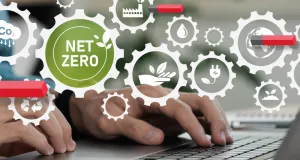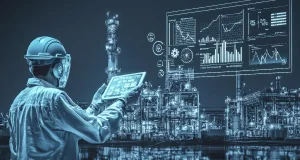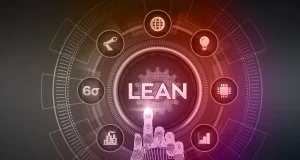Hello and welcome to the first episode of Tech Lyceum, a podcast by Birlasoft. I'm your host, Neerja, and I'm looking forward to bringing you some very unique perspectives on this show. So in this podcast, we're going to be talking about decarbonization in manufacturing and why it's important to shift towards a low carbon future. Now, there's something to be said about how the manufacturing sector can reduce emissions, leveraging technologies to create a clean economy and increase competitiveness on the global stage. Let's hear more about this from our guest today, we have Paul Menig, who has come aboard as a Senior Principal Consultant with Birlasoft. Now he has more than a whopping four decades of experience and has held leadership positions at General Electric Eaton and Daimler Trucks. His experience since graduating from MIT that's right spans across medical defense, aerospace, manufacturing and transportation industries. For the last decade, he has spoken at many, many conferences and has worked with everything from startups to multinational companies on future products strategy and business improvement. He truly is a thought leader and speaker on manufacturing, technology and transportation, and we're very excited to hear his thoughts on today's subject. Welcome Paul. Great to have you.

Thanks very much. It's wonderful to be here.
All right now, Paul, most of the Fortune 500 companies are now making net zero or carbon reduction commitments, right?
Q: How do you see the manufacturing industry play out and move towards a low carbon future?
I like to break it down into three parts based on the organization that's involved. So there's manufacturing operations, there's facilities, and then there's the back office. So the manufacturing operations gets concerned with making process improvements, cost reductions, and now they have the added goal of carbon reduction. They can be using cleaner oils for machines. They can come up with better ways to reduce wastewater. They can recycle the cardboard. These are obvious things they can do. It's less obvious that for carbon reduction, they could also be improving efficiency, improving quality, and speeding the time to manufacture, and applying the techniques for Lean Manufacturing. These are all key performance indicators that manufacturing has had for a long time, and they have a positive impact on carbon reduction by reducing the energy per individual product created. And I look at these all as these are the scope one emissions that people talk about now the facilities department, they're responsible for the energy used in lighting, and they could make more use of LED lamps. They can control heat and air conditioning and isolate different sections of the building. They could redo wastewater processes. They can choose the right sources for electricity that are clean, and they control the time of use that for that electricity. This is what most of us call scope two emissions. Now the back office doesn't get away free. They can control inventory. They can redesign the products to be more environment and mentally friendly. They can choose the suppliers that meet a variety of their current and new requirements, and they can eliminate the low volume, low margin products that are taking far too much time and energy to produce. From what I've seen a key is to get everyone involved and look at everything. Have a leadership team that's in charge of vetting the ideas, setting priorities for the efforts, and then tracking them to completion. We all need to go beyond talking about carbon reduction to actually achieving it. Companies will find that if they focus on saving the planet, they will create short term and long term cost savings for the companies and the results going to be a better company and a better world. But I see a bigger issue. Most everyone has recognized that a company's carbon footprint goes beyond the walls of its own buildings. It can involve every company in the upstream supply chain and everything that's involved in the downstream sales and distribution channels. These are referred to as scope three emissions, and most experts say they represent well over half of the footprint for a company trying to resolve all that,that's where IT comes to play and they help bring all of it together. They play a critical role. The data is going to be coming from various systems that may or may not be interoperable today, so IT can bring it into one set of centralized dashboards, so that all of the people in the CXO office, the chief offices can get the data visibility they need in a simple fashion to know what's going on. And once they can see the data and visualize it, they can see where the hidden carbon hotspots are in their value chain, and that enables them to set the right targets for reduction.
Right that's very well put. And you know, like you said, get everyone involved, because reducing, you know, once carbon footprint benefits everybody. So that draws me to the next question.
Q: We are aware of the Paris Climate Agreement and the need for global coalition to achieve carbon neutrality by 2050 so in your view, Paul, why is it that decarbonization has become such an important issue?
Well, there's widespread agreement in scientific circles that the dramatic increase we've had in population over the last 200 years, from about 1 billion people in 1800 to over 8 billion people today has had a dramatic impact on the earth. It's taxing the resources of our Earth, our food supplies, our atmosphere, and is causing increasing temperatures and more climate issues. Now you mentioned Paris, climate agreement of 2015, these facts have been driven so that all but a few countries have banded together and agreed to the Paris Agreement. The countries have to regularly report their progress to the United Nations, and that progress is their nationally determined contributions. Most recently in November of 2021 they reviewed these at an international conference called cop 26 or COP 26 unfortunately, the world is not making the needed progress to limit temperature rise, so the fact that we're off target is adding additional pressure from the regulators in every Country and shareholders of companies in the United States alone, the Securities and Exchange Commission has now proposed rules for public companies regarding their reporting on emissions against the stated goals they've made, so that the shareholders will get information, allowing them to assess Risk for their company that they've invested in. What's interesting is further that those numbers are expected to be attested to by an independent organization, much as the financials today, of such companies must be run past an outside auditor. The United States Congress is debating the energy innovation and carbon dividend act, Denmark and several other countries are looking at significant carbon taxes on companies, especially those that are subject to the European Union emissions trading system. So shareholders are getting involved directly at many of the shareholder meetings of some of these public corporations, as much as 70% of the shareholders have agreed that we need to accelerate the reduction of carbon emissions within the public company shareholder business, there are also several organizations that review companies and provide guidance to The shareholders on how they should vote on resolutions, and that includes prioritizing votes on decarbonization, because they all recognize that if you don't achieve your decarbonization goals, you are actually risking the viability of the company, which reduces the value of the investment for the shareholders.
Yeah. I mean, it's disappointing that progress isn't being made in the way that it needs to, right? But there's reasons for that, which we'll get to in just a bit right now.
Paul to reaffirm the need to decarbonize, because it's such an important, you know, thing to take into consideration when you're making strategies and plans. What I can infer is that an organization needs to first understand their current footprint, to then evaluate where they are in their decarbonization journey and where they need to go.
Q: So how are organizations measuring this? Is there a standard framework for measurement?
Well, you're right that understanding where you are today is the first step in in trying to get to someplace you want to be in the future, and understanding where you are today with carbon turns out to be a lot more difficult than people expected. As an example, scope one, emissions that we talked about earlier are often calculated in terms such as gallons of wastewater discharged or. Or the total waste recycled in kilograms. The scope two emissions often relates to the electricity and natural gas resources coming into the plant, and those can be measured, say in megawatt hours of clean energy consumed. Now the scope three emissions are often estimates, and they're done in terms of CO two equivalent, we need one place where all the emissions data can be stored, and a need for a global standardized data model. That model would have data collected from multiple sources that would measure the confirmed carbon content, always in terms of CO two equivalent for all the operations across the entire manufacturing value chain. So at Birlasoft, we've been working with multiple clients to build that global data model and store it in the cloud. With that data model in place, we can help them measure their baseline for current carbon impact, we can help them set prioritized and data driven targets for reduction, and then we can continue to measure, report, review and adjust it as necessary in the manufacturing environment, they're all very familiar with the Plan Do Check Act Cycle. They use it daily, and we're just applying that to carbon decarbonization,
Okay. Well, that sounds like a great place to start. Paul recently, there was a BCG global survey which says that although 96% of the organizations have set targets for reducing emissions, somehow only 11% have actually cut their emissions in line with their ambitions over the past five years, right?
Q: What do you think are some of the challenges that they are being faced with in adopting decarbonization, and which companies would you say are doing it right?
Well, the biggest thing I see is that carbon reduction is one of many goals that companies have to work toward. And in the last few years, in particular, companies have been having to focus on more short term issues due to the disruptions from the economy, the supply chain, employee absences and now inflation, rising costs. However, the best companies do find a way to deal with both those immediate issues and still maintain a focus on long term goals such as decarbonization. Another issue is that many countries and companies recognize that they don't have the resources themselves, they don't have the money, they don't have the skills necessary to address and tackle the decarbonization efforts. They have legacy systems in a manufacturing facility that often cannot track the simplest of measurements, such as the time per part, let alone measuring the carbon footprint per part. Some of that legacy equipment may need external sensors that are adapted to enable what people call industry 4.0 type of integration that's going to be needed to track the carbon footprint. I'm also a little concerned about the scope three emissions. It's like everybody wants to say it's outside my walls, and it's somebody else's problem to some extent, and you know that's in the supply and the distribution chains. If it's less than truckloads, such as UPS and FedEx, how would you proportion the carbon impact to the various shippers? If the fleet itself is reporting its improvements in carbon as scope one emissions, should both the receiver and the shipper be able to report some of the same savings as scope three emissions, I would think that might be considered double or triple counting of emissions. Now, you asked about companies. I'm not going to name names, but I do know of an independent engine manufacturer that I think is a good example of a company that gets it right in the long term, and they're one of those few companies that has goals for the near term, the midterm and the long term. In fact, their long term is out to 2050, right now. To make it a priority within their company, they have a name for it. They focus on it on a regular basis. They report on it, not only within the company, but outside the company, and they have a team that's dedicated to measuring and reducing the carbon another encouraging Group of Companies I see are those that we've always referred to as the oil companies. They have recognized the risk associated with just being an oil company, and now have now rebranded to being energy companies. They've recognized that there's strategic risk to the future of their companies, and so they have now diversified to include other forms of energy in their portfolios, especially renewables.
Yeah. I mean, some companies are clearly carefully. Considering how they strategize to benefit the environment, right? And I think you've given us all something not to just think about, but go back and reevaluate as well. I do have one last question for this episode. Q: What do you think are some of the short term and long term strategies manufacturers can set while building the roadmap towards decarbonization.
Well, earlier, I mentioned that I think we can have both a cleaner planet and better companies. So if the companies treat this as a high priority, and they do it right, I see that they'll be able to achieve cost reductions, efficiency improvements, increase the quality of their products and reduce their carbon footprint, especially of the scope one emissions that are under their direct control. And they can do that quickly and have progress made by 2025 now it's natural. Then, once you have that positive momentum that gives everyone the idea that this we can really do, this, it gives them the impetus to work on the next set of improvements, which would probably be from 2026 to 2040 and in that category, some aspects of scope, two emissions will be in that time frame, because it takes time to take A power plant that's using coal or natural gas today, and turning it to using renewable power sources so that we all get lower scope two emissions. Now, the longer range goals which were outlined in the Paris Agreement take us out to 2050, and beyond. The items there that I am aware of being discussed for the long range, includes such things as changing the fuel that we use in airplanes to sustainable aviation fuels, and continuing to investigate how to use hydrogen for planes, for cars and trucks. The immediate future is obviously electric, which is going to be enabled primarily by batteries, and there's one thing I haven't mentioned yet going a step further. So once carbon gets into the atmosphere, you can actually pull it out. And so there are many promising pilot projects that go under the term carbon capture, utilization and storage, often abbreviated, CCUS, and I'm aware of more than 40 projects here in the United States alone since 2018 when a tax credit was passed for those projects. So to me to finish it, manufacturers, irrespective of whether there's getting started on their carbon reduction journey or they're well along the way. They have to understand each and every action that they take in the right direction today will count ultimately in their nation's fight against climate change, absolutely well.
You heard it right here from Paul Menig, the journey to decarbonization is, Yes, a challenging one, but by no means is it impossible with the right strategies and priorities. I think companies can really tackle their decarbonization efforts in a smart and sustainable way. Thanks so much, Paul for letting me pick your brain today. It was great having you.
My pleasure. Thank you.
Well, I hope you learned a little something from this episode of Tech Lyceum, I know I did, and here's something you may or may not know. Birlasoft with its manufacturing mark approach is actually helping businesses speed up their transformation with its platform powered solutions. So whether it's about building a smart factory or powering your supply chain with AI and IoT, we ensure your transformation happens at breakneck speed. That's Birlasoft for you. I will catch you on another episode of Birlasoft Pulse, a really cool podcast series brought to you by Birlasoft. My name is Neerja, and for now, I'm signing off.




